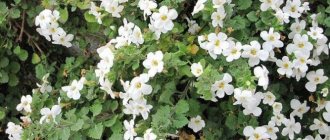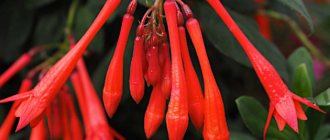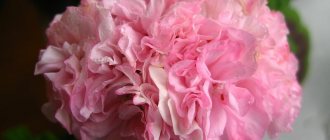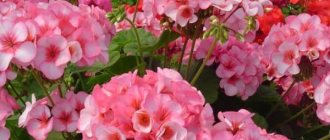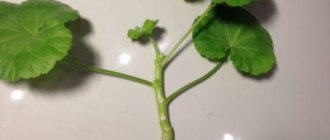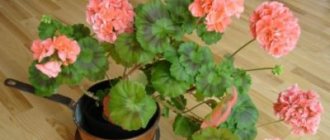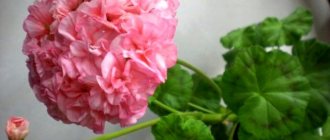The species Pelargonium peltatum stands out not only for its ability to form elegant, but quite strong flowing shoots up to a meter long. A characteristic feature of this variety of indoor geranium is its dense five-fingered leaves of even green or variegated color. See also the photo of the oleander flower!
In the axils of the leaves, at the tops of the stems, tall peduncles are formed, bearing lush umbrella inflorescences. Flowers can have different shapes, from simple star-shaped to double or pink, and a wide variety of colors. Flower growers have varieties with single-color and two-color corollas with a diameter of 1.5 to 4 cm at their disposal.
Ampelous pelargonium: home care
In order for a flower to please with its healthy appearance all year round, it needs to create conditions suitable for life. And for this you need to know what the requirements of ampelous geranium are (care and cultivation, pinching), the characteristics of each growth period.
Ampelous geranium
Summer care
Active growth of geranium lasts from early spring to late summer. At this time, home care for pelargonium should consist of:
- timely watering. You need to moisten the flower when the top layer of the substrate gradually dries out. You can overdo it in this matter; you can’t water it very often, the flower won’t be grateful for it. So you should always keep watering under control, watching the ground;
- periodic feeding;
- pinching new shoots and pruning.
Ampelous pelargonium
Winter care
Caring for pelargonium in winter and summer is different. Unlike the warm period of the year, in cold weather the ampelous geranium rests.
Note! This time is very important for her, because how strong the flower will be during the period of active growth depends on how the winter goes.
Proper care of geraniums in winter is:
- location of the flower in a cool place (temperature approximately 5-12 ° C);
- diffused but bright room lighting;
- water rarely, about once every 2 weeks;
- Pelargonium pots should be located far enough from radiators and other heat sources.
Watering
When watering pelargoniums, it is important to remember that these are fairly drought-resistant plants, while at the same time easily susceptible to fungal diseases. Therefore, it is better to underwater the plant a little rather than overwater it.
In summer, water as the top layer dries, provided that the plant is in a warm and sunny place. In winter, in cool conditions, watering should be limited, but not allowed to completely dry out the soil.
Signs of excessive watering will be limp, drooping leaves, often with signs of gray rot; in severe cases, the stem will begin to rot, which almost always leads to the death of the plant. Another symptom of excess moisture is the appearance of “sores” on the underside of leaves. When the earthen clod dries out, the plant stops blooming, the leaves turn yellow, and their edges dry out.
Air humidity is not important for pelargoniums; these plants do not require spraying. Excessive dampness and stagnant air can cause fungal diseases.
Features of growing ampelous pelargonium outdoors
How to propagate ampelous geranium at home
Pelargonium feels great both indoors and outdoors. Therefore, ampelous geranium is often planted in the ground. The requirements for a flower planted outdoors remain the same as for care at home. For lush flowering and healthy growth, it needs watering, fertilizing and periodic pruning.
Ampelous geranium on the street
Selecting a location
The most important thing for planting geraniums outside is the composition of the soil. It is the well-chosen soil that will give strength to the flower. The soil must be free of stagnant groundwater, this way the roots of the flower will be protected from rotting.
For your information! Another important point is that geranium does not like clay and loamy soil, so places with such soil are not suitable for planting a flower.
Lighting
Ampelous geranium prefers very bright places. Thanks to the sun, pelargonium begins to bloom profusely, otherwise the buds fall off and only the stems begin to grow. It is important to take into account that, like many other flowers, ampelous geranium does not really like direct sunlight, so the place should be moderately lit and hidden from direct sunlight.
Temperature
During the flowering period, ampelous geranium should be in a warm place. The best temperature for this flower is approximately 18 °C. However, the plant is not afraid of cold weather, so there is no need to worry about the winter period.
Important! Since pelargonium most often hangs down from the pot, spreading its leaves, you need to choose a place for the flower so that its branches are not deformed by the wind.
Content
- Boarding and seating
- Basic care Watering
- Feeding
- Autumn pruning
- Rest period
- From the mother bush
Hans Braxmeier / Personal archive
The beauty of all hanging plant species is undeniable, and ivy-leaved pelargonium (Pelargonium peltatum) is one of them.
An unpretentious, spectacular plant that can change the appearance of any building beyond recognition , be it residential or administrative. House facades, loggias, balconies, terraces, gazebos - it would take a long time to list where this pelargonium is applicable.
It seems that its popularity is only growing with each season, which is facilitated by its bright, catchy colors - the inflorescences are white, red, purple, pink, bicolor.
Jonathan Billinger / Personal archive
Of course, unpretentiousness does not mean: plant it and forget it - no. respond with great gratitude and increased attention to themselves.
The most common pests and diseases
Unfortunately, like almost every flower, geranium is also subject to some diseases, sometimes even pests appear on the plant. If not properly cared for, geraniums can be affected by gray mold, viral mosaic, various harmful fungi or caterpillars.
Royal geranium - home care for beginners
Only chemicals that are sold in specialized stores will help solve the problem. But, in order to prevent this state of geranium, it is easier to care for it properly.
Note! Infection can be caused by overwatering, insufficient lighting or improperly selected fertilizers.
Feeding ampelous pelargonium for lush flowering
Bacopa ampelous - growing and care at home
During the flowering period, geranium needs feeding. You can help the flower during this period with the help of various fertilizers, which are added to the soil throughout spring and summer.
In this case, a complex of mineral fertilizers comes to the rescue. Also, flower growers sometimes use milk as a top dressing. But you should be careful; first, just like other fertilizers, it must be diluted with water.
Lush flowering of ampelous geranium at home after proper care
Important! Organic fertilizer is not suitable for hanging geraniums.
For fertilizer purposes, substances such as phosphorus, potassium and magnesium sulfate are also used, which also need to be diluted with water.
Popular varieties
Ampelous geranium is represented by only one variety called “ivy-leaved”. A large number of varieties of this plant are known, bred by breeders over four centuries. The type of “ampeloid ivy-leaved geranium” includes many varieties:
- dwarf;
- plain;
- two-color;
- variegated;
- terry.
The least demanding varieties are more popular.
Pruning and shaping the bush
Why do you need to prune geraniums? This question is most often asked by novice gardeners, because the flower is already growing, why break it off? Pruning pelargonium is necessary so that the bush has a neat appearance. It also helps the flower not to waste extra effort on stretching it to unnecessary lengths. Thus, the plant gives all its energy to flowers and lush leaves. In addition, pruning allows you to obtain cuttings for flower propagation.
Trimming
Important! Pruning can only be done on an already mature bush. Young plants may be damaged by this method of creating a flower shape.
All about pruning and pinching pelargonium
The main difference between pruning and pinching is that the former is considered a drastic way of changing the shape of a plant by removing entire branches. This is necessary so that the flower is formed in the form of a bush, otherwise, if pruning is not done and the flower is allowed to grow the way it wants, the branches will stretch out, and the plant itself will produce a minimum number of flowers.
In the second case, only the tips of the stems, namely the growing points, are pinched. The advantage of this method is that over time, not one, but several young shoots appear at the pinching site. In this way, you can achieve greater splendor and bushiness of the flower.
The most important thing when pruning and pinching:
- use the right tools. For pruning plants, only a sharp tool is suitable, which will not unnecessarily harm the flower;
- wash or disinfect your hands before the procedure so as not to infect the flower with diseases.
The plant needs to be trimmed before each wintering. In this way, the geranium will be able to maintain its strength during the cold period and bloom magnificently in the spring.
Pinching, in turn, is a procedure that is best carried out at the end of winter or early spring, but forming a bush is not prohibited at a later time, when the plant is already blooming.
Important! If there are diseased shoots on the flower, then pinching them is useless. In this case, it is better to cut the branch. This will keep the rest healthy.
Growing pelargonium yourself
Growing a flower is always a fascinating process, especially if the plant was not originally purchased in a store, but planted yourself. Growing geranium can be done by propagating the plant by cuttings or using seeds.
Germination
Growing from seeds
The most favorable period for geranium seed germination is December to April. The procedure consists of several stages:
- For the soil, use a mixture of peat, sphagnum, garden soil and sand.
- The prepared soil with seeds must be moistened and placed under a film to form a kind of greenhouse.
- It is worth storing the flowerpot with seeds in good lighting. The room temperature should be 22-24 °C. Under these conditions, the seeds begin to germinate in about a week.
- After waiting 3 weeks, you can pick the sprouted seeds.
How to grow from cuttings
To propagate pelargonium by cuttings from a ready-made bush, you need to cut off a branch. It is best to do this in the summer. The cutting can produce roots in water or directly in the ground. After the shoots have rooted and several leaves have appeared, it is recommended to pinch them. This way the bush will gradually grow and become more magnificent. If you care for the cuttings in the right way, within a year the sprout will delight you with flowers.
Transplanting pelargonium
Replanting greatly affects the health of the flower. It is best to carry it out in early spring. This procedure is most often performed to increase space for the flower. Thus, a pot with a diameter of 1.5-2 cm larger than the previous one is better suited for replanting. Planting pelargonium requires care and attention, so you should be careful.
Important! Expanded clay should be placed at the bottom of the new pot so that excess moisture does not remain but evaporates.
Homemade ampelous pelargonium is becoming one of the favorite flowers for housewives not only because it blooms very beautifully, but also because it is undemanding in care. In order for the flower to always remain lush and beautiful, you just need to be careful and follow simple but important rules for geraniums.
Landing instructions
Prepare everything you need: container, seedling (preferably several for a beautiful bush shape) of ampelous pelargonium, drainage, soil, watering can, spatula.- The pot is filled with a layer of drainage (approximately 1/4 of the total volume) and soil.
- In the container, using a spatula, alternate depressions are made into which pelargonium seedlings are immersed at the same distance from each other.
- Each seedling is covered with earth, which should be pressed tightly at the base of the shoot for better fixation.
- The plant needs to be watered.
Ampelous pelargonium does not tolerate stagnant moisture in the pot, which can cause rotting of its roots. Therefore, you should not forget about drainage in the pot (expanded clay, crushed brick, broken polystyrene foam, etc.), as well as drainage holes in the bottom of the container, designed to drain excess liquid.
Lighting and location
Ampelous pelargonium loves bright sun and requires sufficiently long daylight hours (about 16 hours) for full development. The flower tolerates dry periods relatively easily and feels great outdoors. The best place for pelargonium to stay in the warm season will be balconies, windows, gazebos, terraces or flowerpots placed on the garden plot. The desired direction is south, southeast, southwest.
Soil requirements
Soil that is optimally suitable for planting ampelous pelargonium should have such characteristics as looseness, lightness, air and moisture permeability. A mandatory element of the substrate that provides all these requirements is peat and coarse sand. You can buy ready-made soil in a store or prepare it yourself: mix peat, sand, turf, and leaf soil in a 1:1:1:1 ratio.

